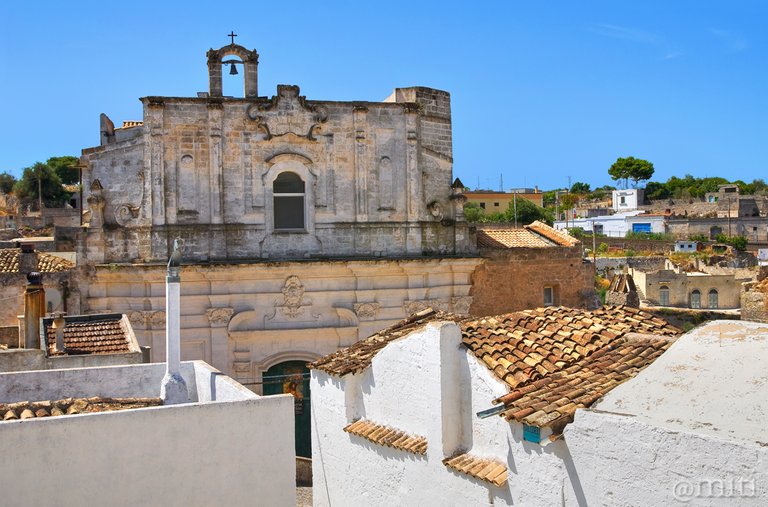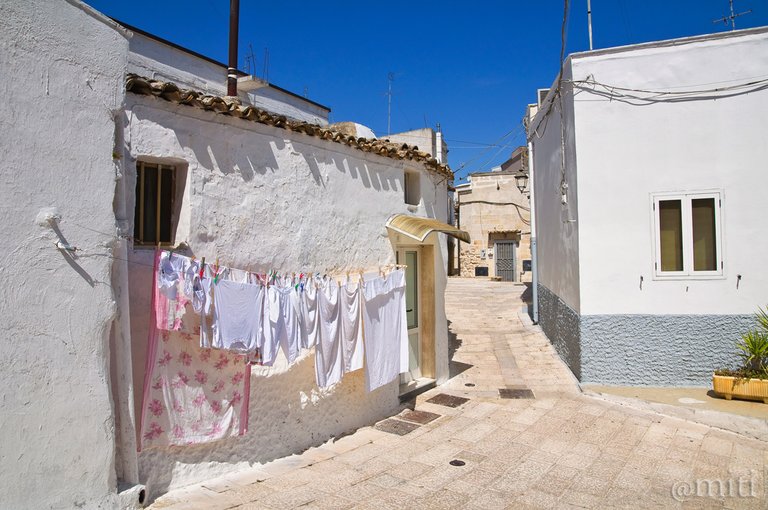
A panoramic view of Laterza (Author's photo - All rights reserved)
Vista panoramica di Laterza (Immagine dell'autore - tutti i diritti sono riservati)



Ciao a tutti,
questo è un viaggio attraverso l'Italia. Posterò una foto al giorno con una brevissima descrizione. Spero vi piaccia!

Laterza è un piccolo borgo della provincia di Taranto, nella regione italiana meridionale della Puglia. Situato all'interno del Parco Regionale "Terra delle Gravine", il suo canyon, Oasi Lipu, è uno dei più grandi d'Europa con un'estensione di 12 km (e anche fino a 500 metri di larghezza in alcuni punti) e con un panorama mozzafiato ricco di pareti a strapiombo, di cavità e grotte, di rapaci e fiori incantevoli.
Laterza ha una storia molto antica. Gli scavi degli anni '60 nella zona di Candile hanno portato alla luce reperti risalenti all'anno 2000 a.C. Situato lungo la Via Appia, che collegava Taranto a Roma, la via romana più celebre è ancora visibile in alcuni punti. Molti reperti dell'Antica Grecia sono stati estratti anche dal suolo, ma anche risalenti al periodo romano e del Medioevo; tutto ciò testimonia come Laterza sia stata un importante centro per la produzione ceramica sin dalle epoche più remote.
A partire dal Medioevo, la città sviluppò le sue attività nella produzione della preziosa maiolica bianca e lucida. Le forme, le decorazioni e i colori utilizzati dai ceramisti sono assolutamente speciali e sono un tratto distintivo nella produzione ceramica nazionale.
Le spesse mura della città, il profondo burrone e il castello circondano il centro storico, evidenziando così la sua anima medievale che si distingue grazie alle numerose case imbiancate lungo i vicoli, le scale e le pittoresche piazze.
Nel cuore del centro storico il campanile della chiesa di San Lorenzo si erge alto e splendido, come una stella guida che indica l'uscita dai vicoli bianchi. La chiesa è il primo esempio di architettura dalmata mescolata con il romanico pugliese.
Costruita nel 1408, la Chiesa di San Lorenzo ha molte caratteristiche architettoniche in comune con altre chiese in Puglia, come quelle di Mottola, Manduria e Ostuni. Una delle caratteristiche principali è il maestoso rosone, decorato con piccole colonne e archi.
Il palazzo Marchesale è un edificio del XVII secolo, a cui è stata data una nuova prospettiva di vita negli ultimi anni. L'edificio fu originariamente concepito come castello nel 1393, quando il feudo di Laterza faceva ancora parte del principato di Taranto. Nei secoli, il castello fu distrutto e un palazzo prese il suo posto. Oggi sono ancora visibili alcuni resti dell'edificio originale: parte del fossato, parte delle mura con le loro merlature, che proteggevano il lato settentrionale del cosiddetto castrum de tertia (il nome latino originario del villaggio) e, verso sud , un tunnel che portava al burrone e permetteva alla gente di fuggire dal castello.
La fontana cinquecentesca (Fontana dei Mascheroni) situata nel centro storico di Laterza fu restaurata dal marchese Pietro Antonio d'Azzia nel 1544, così come riporta lo stemma posto in facciata e la sua architettura conserva ancora le sue origini romane.
Cose da vedere: Il Centro Storico, la Chiesa di San Lorenzo, il Palazzo Marchesale, la fontana cinquecentesca (Fontana dei Mascheroni), il Santuario Mater Domini, la Chiesa della Madonna delle Grazie, il Museo MUMA, il museo della Civiltà Contadina, l'oasi LIPU di Laterza, la Gravina.

Hello everyone,
I began a Photo Journey through Italy. I will post one photo every day with a little note of explanation. I hope you like it!

Laterza is a small town in the province of Taranto, in the southern Italian region of Puglia. Located inside the Regional Park of “Terra delle Gravine”, its canyon, Oasi Lipu, is one of the largest one in Europe with an extension of 12 km (and even up to 500 metres wide in some points) and with a breathtaking panorama rich in sheer walls, caverns and caves, raptors bird and enchanting flowers.
Laterza has a very old history. The excavations of the sixties in the area of Candile brought up finds dating back to the year 2000 b.C. Situated along the Via Appia, which connected Taranto to Rome, the most celebrated Roman street is still visible in certain points. Many finds from Ancient Greece have also been extracted from the ground, but also from the Roman period and the Middle Ages; all this bears evidence to how Laterza has been an important centre for ceramic production since the most distant ages.
Starting from the Middle Ages, the town developed its activities in the production of the precious white and glossy majolica. The shapes, decorations and colours used by ceramists are absolutely special and are a distinguishing feature in the national ceramic production.
The thick city walls, the deep ravine and the castle surround the historic centre, thus highlighting its medieval soul which stands out thanks to the several white-washed houses along the alleys, stairs and picturesque squares.
In the heart of the historical center the bell tower of the church of San Lorenzo stands tall and splendid, like a guiding star that points the way out of the white alleys. The church is the first example of Dalmatian architecture mixed with Apulian Romanesque.
Built in 1408, the Church of San Lorenzo has many architectural features in common with other churches in Apulia, like those of Mottola, Manduria and Ostuni. One of the main features is its majestic rose window, decorated with small columns and arches.
The Marquis’s palace is a XVII century building, which has been given a new lease of life in the past few years. The building was originally conceived as a castle in 1393, when the feud of Laterza was still part of the principality of Taranto. In the centuries, the castle was destroyed and a palace took its place. Today, some remains of the original building are still visible: part of the moat, part of the walls with their battlements, which protected the northern side of the so called castrum de tertia (the original Latin name of the village) and, towards south, a tunnel which led to the ravine and allowed people to escape from the castle.
The sixteenth-century fountain (Fontana dei Mascheroni) located in the historical center of Laterza was restored by Marquis Pietro Antonio d’Azzia in 1544, as the emblem still visible on its facade shows, its architecture still preserves its Roman origins, too.
Thing to see: The Historic Centre, the Church of San Lorenzo, the Marquis’s Palace, the sixteenth-century fountain (Fontana dei Mascheroni), the Sanctuary of mater Domini, the Church of Madonna delle Grazie, The MUMA Museum, the museum of Rural Life, the LIPU oasis of Laterza, the Ravine.

| Tipo di foto / Category | Paesaggio / Landscape view |
| Esposizione / Settings | 1/320 sec, ISO 200, f/10 |
| Camera | Nikon D5000 |
| Lente / Lens | Tamron SP 17-50mm f/2.8 XR Di II LD |
| Filtro / Filter | Polarizzatore Hoya / Hoya Polarizing filter |
| Cavalletto / Tripod | Manfrotto MKC3-P01 |
| Località / Location | Laterza (Taranto), Italia |
| Software | Photoshop |


Alleyway in the historical center (Author's photo - All rights reserved)
Vicolo del centro storico (Immagine dell'autore - tutti i diritti sono riservati)
Congratulations, Your Post Has Been Added To The Steemit Worldmap!
Author link: http://steemitworldmap.com?author=mitiPost link: http://steemitworldmap.com?post=a-journey-through-italy-one-photo-every-day-108-laterza-eng-ita
Want to have your post on the map too?
@miti its look like village and very old church beautifull village
Itlay has many beautiful sites to view..... I'm really glad and looking forward to your posts Thank You so much
You're welcome!
(PRESALE IS LIVE.) SOUNDEON - Blockchain music platform that changes everything
LINK —- http://bit.ly/soundeon ( Affiliate link)
Sorry for the obsessive advertising. It is necessary to earn.
Your comment is considered SPAM... Take a look in this guide:
https://steemit.com/steemit/@miti/a-complete-guide-for-newcomers-and-minnows-to-avoid-a-possible-spam-and-to-write-good-comments
It will help you.
Congratulations @miti! You have completed the following achievement on Steemit and have been rewarded with new badge(s) :
Click on the badge to view your Board of Honor.
If you no longer want to receive notifications, reply to this comment with the word
STOPTo support your work, I also upvoted your post!
You got a 31.83% upvote from @ocdb courtesy of @miti!
I use a canon is that a good camera to use?
Yes, but it's important the lens, too.
I can take nice pictures there. I should plan a trip right there.
I don't see why not..
very intresting, beautiful photos, i like Italy, enjoy you traveling, have fun
Thanks!
Nice view
Il cielo blu é il tuo marchio :-D.... praticamente se uno ti porta con sé ha il bel tempo garantito?
Excellent article. I really liked it. Good luck to you and Love.
Que belleza de fotografía, como me gustaría vivir allí, tanta tranquilidad.
Wonderful story, excellent photos, reflect each of them the essence and sincerity of your words made prayer ... the miracles exist only we must have faith and put our way in the hands of God ... I am touched by your writing ... I congratulate you. I invite you to visit my profile, I would love to have your help. Thank you.
Your comment is considered SPAM... Take a look in this guide:
https://steemit.com/steemit/@miti/a-complete-guide-for-newcomers-and-minnows-to-avoid-a-possible-spam-and-to-write-good-comments
It will help you.